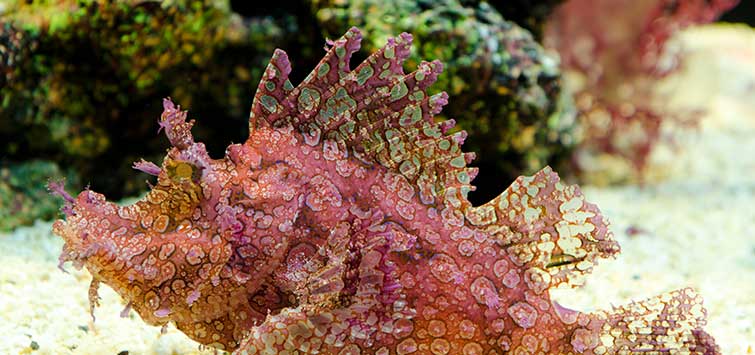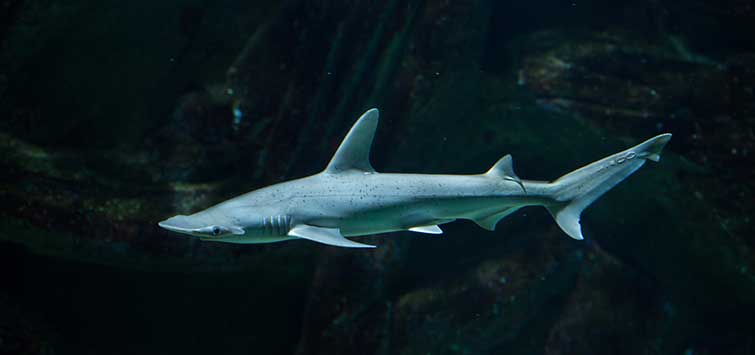Top of the Food Chain: A Conservative Look at Rhinopias Scorpionfishes
Author: Brian M. Scott
Over the last 10 years or so a small group of reef scorpion fishes have become increasingly popular and highly sought after for collectors of rare and exotic marine fishes. Belonging to the genus Rhinopias, these fascinating creatures elicit a reaction in even the most jaded marine hobbyists. Their beauty, however, comes by way of a cost, both to the wallet of the keeper and to the population of these awe-inspiring creatures.
Conservation Caution
Rhinopias are only scarcely encountered throughout their range. While this may actually be in large part due to their cryptic coloration and ability to camouflage themselves particularly well, conservation-minded hobbyists are increasingly highlighting the pressure that collecting these fish is having on their wild populations, and some believe that severe harm may be done to the wild populations of Rhinopias in the next decade or two if measures are not taken to reduce their collection now.
Because they are not listed as important food fishes but rather appear to have no use other than collection for the aquarium exotics trade, if a sharp decline in Rhinopias is observed it is likely that the aquarium industry will suffer the full blame and be called upon to take whatever steps may be needed to protect this speciesin the future.
Warnings
This concern among advanced aquarists and academics is not new, and for some time now we have seen sporadic warnings pop up here and there in various publications. Several years ago, while spending an afternoon at a marine wholesaler in northern New Jersey, I had a conversation with some of the folks there about the importation of these creatures.
The discussion started when I asked where it was that these interesting-looking fish were collected. The concern about their removal from the wild was not something that had us up in arms, but was nevertheless on our minds. At the time, I was not much interested in Rhinopias other than the common “wow, that’s a cool fish!” reaction that most everyone has upon setting eyes on one—especially the brilliant red Rhinopias species known as R. eschmeyeri (which, I’ll interject here, may possibly not be a valid species).
What We Can Do
That being said, there are things that we in the aquarium hobby can do to ensure that future generations of fishkeepers have the luxury of enjoying Rhinopias in their aquariums in the decades to come. For one, if we desire to keep such fishes, we should do our homework to make sure that everything possible is done to provide them with a high quality of life and a solid chance at surviving in our aquariums.
Additionally, importers and retailers should do what they can to ensure costs remain high for these fish. With their purchase costs at a high level, hobbyists that are not as serious about keeping Rhinopias will be less inclined to buy them, and thus a small amount of pressure is taken off the wild stocks. For better or worse, this latter condition is already in place, as, without getting into exact numbers, it’s safe to say that the cost of a Rhinopias scorpionfish is about the same as an average week’s paycheck for most Americans.
Now that the conservation lecture is out of the way, let’s have a look at what it takes to actually keep these critters in our little glass boxes.
Space: Not What You Would Think
For a welcome change, here we have a fairly large-growing group of fish that do not necessarily need huge space accommodations. Imagine that! With the largest of the genus growing to about 10 inches in total length, you may think that such a beast needs at least a volume of 75 gallons or more—not so. The reason is that these fish barely swim.
It’s truly a wonderful thing, and to be completely honest some of the most striking displays that I have with Rhinopias as the centerpiece were small aquariums, usually cubical in dimension, that held about 30 or 40 gallons. Now, of course I would never recommend keeping them in smaller quarters, I am simply stating that they do not need the space that many other predatory fishes of similar size require.
Tankmates Beware
Rhinopias are best kept alone in a species-specific aquarium, where they can be displayed as a single show fish. I say this for two main reasons. The first is that Rhinopias tend to swallow nearly any fish that you are likely to place in their aquarium, especially if maintained in a rather small one. The second reason is that often tankmates too large to be swallowed are likely to pick at the sensitive fleshy extensions found on most species of the genus. Both R. aphanes and R. frondosa, for example, exhibit a striking display of these fleshy extensions, which are thought to serve as a sort of camouflage to both deter predators and help them gain an advantage over their prey, which are inhaled whole as soon as the unknowing victims wander too closely.
Diet Demands
Captive Rhinopias usually need to feed on living fare. Of the many choices that hobbyists are presented with to accomplish this, there are a few that are more likely to be accepted than others. In most cases, some species of live fish should be used to initiate newly acquired specimens. Common fishes used for this are goldfish, minnows (rosies), guppies, mollies, and in some cases damsels. I have used damsels with a lot of success, and although they are expensive they initiate an almost instantaneous feeding response. Other hobbyists have used live shrimps, like grass shrimp, with similar results.
Variety
Once your specimen is regularly feeding—which basically means that he is eating whenever you offer food—you should attempt to expand the menu a bit. I am a huge fan of a varied diet, and the fish will show better color, vigor, and overall health when fed a wide variety of food organisms. When offering other foods, it’s best to use a feeding stick, as this will allow you to move the intended prey back and forth in front of the predator. The movement alone will sometimes trigger an aggressive feeding response.
Alternate foods should consist of shrimp, clam, squid, fish flesh, and lump crab meat. Another reason a varied diet is healthier compared to one consisting primarily or wholly of live feeder goldfish, for example, is that raw goldfish flesh contains thiaminase, an enzyme that causes the breakdown of thiamin. If you feed your scorpionfish a diet that consists only of goldfish, they may become thiamin deficient, which can result in feeding cessation, clamped fins, and nervousness in coordination.
Feeding Schedule
Feeding schedules should be adjusted as the fish acclimate to their new surroundings and grow. Since Rhinopias tend to be sluggish in their behavior and don’t actively seek out prey with as much movement as is associated other predatory fishes, we don’t need to offer them huge amounts of food. Additionally, if you house your Rhinopias in a smaller aquarium, say one in the 30-gallon range, the water quality will suffer dramatically if overfeeding is a constant occurrence.
Rhinopias should be fed to satiation about three times weekly. Small individuals may be fed up to four times weekly, but I don’t recommend this unless the tank is very stable and an efficient biological filter is being used in addition to a protein skimmer. Rhinopias do not tolerate poor water, and making sure that nitrogen compounds as well as metabolites are maintained at the lowest possible levels is a necessity if you are to be successful with this group in the long term.
Diseases
Most scorpionfishes, including Rhinopias species, are prone to parasitic infestations of their slime coat. Even though Rhinopias are capable of shedding their external epidermal layer, they still can become infested with various types of parasitic protozoa. Many times, marine velvet or ich is the primary irritant, but occasionally external bacteria and fungal infections take hold, too.
Most of the time, bacterial infections are caused by tankmates picking on the fleshy appendages of the Rhinopias species. Secondary fungal infections often infect these wounds if the cause of the wounds is not removed, or if the wound is stubborn and not reacting to treatment for the bacterial infection. In most cases that I have seen, these secondary infections can be easily cured as long as the environment is kept clean and the infection is caught early.
Whenever medicating Rhinopias, try to use only half of the manufacturer’s recommended dosage, as they are very sensitive to treatments. Additionally, many of the common or traditional anti-parasitic treatments may be too strong for these fishes. Using organic remedies has proven to be effective, but I have found that the most effective method of treating Rhinopias is by in-feed medications, which are injected into the food and then fed directly to the fish.
Venom!
Use extreme caution when handling and transporting Rhinopias. Their dorsal spines contain venom, which may cause extreme pain and a possible allergic reaction if the skin is punctured. Additionally, some people may have a potentially fatal reaction to contact with the venom of these and other scorpionfish species. Use extreme caution at all times.
Shedding
Rhinopias will occasionally shed their outer “slime” layer. Shedding this slime coat, which is actually an outer epidermal layer, helps to rid the fish’s body of algae buildup and parasites. Shedding may occur weekly, bi-weekly, or even monthly depending on the individual. The frequency of shedding may increase if the fish is suffering from parasitic infections, and the eyes may cloud up just prior to shedding.
The Crown Jewels
The scorpionfishes of the genus Rhinopias are fascinating and rare creatures, and they can be the crowning jewel of a rare fish collection. However, along with keeping these fishes comes a responsibility to do everything possible to provide the best environment you can for them. Rhinopias are rarely found throughout their range, though perhaps “uncommonly seen” is more accurate, as experts agree that camouflage is certainly a factor and these fishes may simply go unnoticed much of the time. Regardless, it is our responsibility as conscientious fishkeepers to ensure that we provide the utmost in care to such scarcely seen fishes in order to reduce any possible extra pressures on their wild populations.
Once established, Rhinopias tend to adapt well to life in an aquarium. As with all fishes, a good diet, high-quality water, and as few stressors as possible allow these species to live for years in your care. Even though Rhinopias species can be kept in relatively small aquaria, I still must emphasize that these fishes are best suited for only advanced hobbyists, and preferably public aquariums, due to their conservation status—and their venomous spines!

.png?h=595&iar=0&w=2781&hash=5FD5E69473BCC22199FBFA2FB71B6033)



